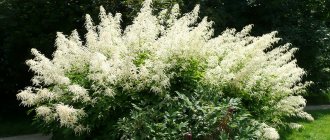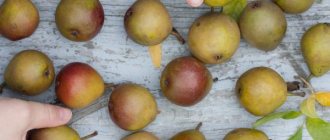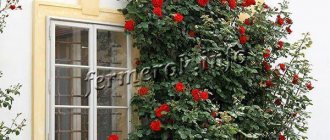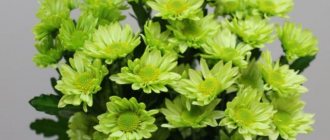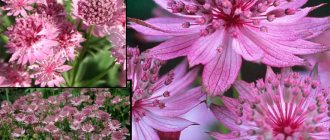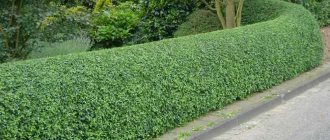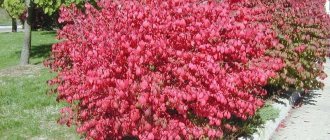Modern architectural trends are slowly eliminating fences. Often, stone and metal fences are replaced by evergreen hedges. Beautiful natural hedges surround us everywhere, become a buffer from reality, protect us from the prying eyes of neighbors, separate us from noise, and symbolically transform the yard into a safe fortress. Anyone can plant evergreens; they don't require special care, complicated maintenance methods or large financial outlays. Check out the best fast-growing shrubs for the job.
The green fence is not a modern invention. Over the years, it changed its function and gradually became more decorative. Especially in the 18th and 19th centuries, when royal and magnate gardeners used fast-growing ornamental shrubs to form hedges and various types of evergreens to create elaborate decorations in royal gardens. How to create an evergreen, perennial and fast-growing hedge, what trees and shrubs to use – we’ll look at this article.
Advantages of hedges
Green spaces as a fence are not inferior to, and in some aspects even surpass in functionality, fences made of brick, wood, stone, and blocks.
The disadvantage of this solution is the need for planting care, but among the suitable plants there are many unpretentious ones that require a minimum of attention.
The second disadvantage is the shorter service life of the fence, but there are long-lived crops, for example, yew can live more than 4,000 years.
More advantages:
- A hedge made of bushes is suitable not only for marking the boundaries of a site, but also for dividing the internal territory into zones. It is not advisable to use fences for this purpose.
- Green growth looks more picturesque than artificial fences.
- A wall made of shrubs, permeable to air currents, is more suitable for protection from wind than a solid fence. No vortices are formed on its inner side and in the corners, and nearby plantings do not suffer from drafts.
- If you plant bushes with a dense crown along the perimeter, the air in the area will become fresher than outside it.
- Some plants emit pleasant aromas during flowering.
- Shrubs absorb sound well, and planting them is easier than installing a noise-protection fence.
The benefits of green space
A green wall has many advantages:
- A beautiful living fence creates the first impression of the owner of the house.
- Proper placement of a green fence improves the aesthetics of the site.
- By cutting, you can change the shape of the fence.
- Economical. Having planted a fence once, you can avoid spending money on its repair for many years.
- A beautiful view of the landscape lifts your spirits and calms your nervous system.
- Protects from uninvited guests and prying glances.
- Cleans the air from dust and harmful impurities.
Problems to be solved
A green fence not only protects a dacha or private house from view, it can disguise an ugly fence or outbuildings, create a backdrop for other decorative elements, or serve as a bright accent in the landscape.
If you choose the right shrubs for a hedge, you can use it to solve several practical problems.
Create a barrier to entry
Tall and dense bushes with thorns will stop not only animals, but also humans.
In addition, the thorny fence will not be eaten by cows and goats, and hares will not gnaw it in winter.
Suitable for this:
- hawthorn;
- barberry;
- blackthorn;
- rose hip;
- Mahonia;
- prinsepia chinensis;
- sea buckthorn;
- raspberries (for small hedges).
Of course, there are other varieties of thorny shrubs, but these are the most accessible and easy to care for, and they grow quickly.
Provide sound insulation and dust protection
In this case, it is necessary to surround the area with shrubs that form a thick, dense crown.
You can plant:
- lilac;
- honeysuckle;
- spirea;
- felt cherry;
- derain;
- forsythia;
- mock orange
The most reliable barrier, which will help even if there is a highway next to the dacha, is formed from three rows of plantings.
Shrubs are placed on the inside, fruit trees are planted behind them, and then tall deciduous or coniferous trees.
In small areas the last row is not done.
Protect from drafts
Even the translucent line of bushes dispels the wind. In winter, when the bushes are bare of leaves, there are enough bare branches to break up the air currents.
Choose wind-resistant species whose branches are flexible enough not to break even under strong gusts.
These include:
- holly;
- yew;
- vesicular carp;
- privet;
- European euonymus;
- irga roundifolia;
- dogwood (common and blood red);
- elder;
- hazel;
- lilac;
- rose hip;
- hawthorn.
Some of them are not fast growing, such as yew, but if you want a hedge that will last for decades, then this is a great option.
Attract pollinating insects to the garden
Abundantly flowering shrubs are not only decorative, but also attract honey-bearing insects to the site.
Not all plants are equally interesting for bees and bumblebees, only nectar plants.
Plant it in your dacha.
| Cinquefoil shrub | Bobovnik |
| Lilac | Weigelu |
| Hydrangea | forsythia |
| Spiraea | Lagerstroemia indica |
| Camellia japonica | Oleander |
| Derain white | Tatarian honeysuckle |
| Mock orange crown | Caragana tree |
| Mahonia |
Prevent soil erosion
If the site has uneven terrain or is located on a slope, melt and rainwater gradually destroy the soil cover.
If the angle of inclination does not exceed 30°, planting shrubs is the best way to stabilize the soil. This method is simple, environmentally friendly and decorative.
Shrubs with a developed root system can cope with this task, such as:
- honeysuckle;
- Aralia;
- privet;
- derain;
- cotoneaster horizontal;
- rose hip;
- vesicular carp;
- barberry;
- spirea;
- caragana tree;
- creeping willow;
- Stephanandra incisifolia.
Willow hedge
It is especially worth paying attention to the rosehip, which grows quickly and can perform several functions at once.
Requirements for a hedge
The range of shrubs for vegetable fencing is large, but regardless of what practical and decorative problems it must solve, there are selection rules that are relevant for all cases:
- Choose fast-growing shrubs - a full-fledged hedge will grow within 2-4 years.
- It is desirable that the height of an adult plant coincides with the required height of the green wall. The fact is that some crops begin to wither when the top is removed.
- Avoid bushes with massive leaves. It is more convenient to shape a crown with small foliage.
- Plants must be resistant to frost and drought, diseases, and lack of nutrition. Then caring for the planting will be as simple as possible.
Well, density is important, one might say the main factor for the sake of which this whole hedge story is started.
Plants for hedges. Top 17 best shrubs.
Undesirable plants for hedges
It is a mistake to think that any shrub of suitable habit and zoning is suitable for the role of a hedge.
Some of the care measures performed for separately growing specimens are difficult to implement for a number of plants located close to each other.
It is difficult to cover a hedge for the winter, so do not use crops that do not have the necessary frost resistance to create it.
Otherwise, individual “links” of the fence will have to be replaced every year, risking damage to their healthy neighbors during this operation.
In the worst case, the planting will freeze entirely.
Plants susceptible to diseases and pests are also not suitable. A shrub hedge cannot be thinned, while a dense tangle of branches is a favorable factor for all pathogens.
It will not be possible to thoroughly treat the dense crown with fungicides or insecticides; some of the parasites will survive.
As a result, chronically diseased bushes will begin to weaken and lose their decorative properties.
A bad option for green canopy are crops that need to be replanted every few years. If you do not do this, the plants will gradually degrade and lose their attractiveness, immunity and vitality.
Shrubs that are very prone to overgrowth are difficult to keep “in bounds” by pruning. They take up too much space, and if planted on the border of plots, they begin to take over the territory of neighbors.
The plant can be spreading and voluminous, but must have a limited size, beyond which it does not grow.
Fast-growing hedges of uniform shrubs
Monotonous planting is the simplest option for a green fence. It is appropriate as a background; it is a reliable solution if there are a lot of color spots in the area.
Those who are not confident in their artistic talents should choose plants with white flowers.
If the landscape is kept in neutral colors, a uniform border or wall may look inexpressive. Plants with leaves of non-standard color are suitable for this case.
In addition, many deciduous hedge shrubs turn showy orange or red in the fall and bloom beautifully in the spring or summer.
Hawthorn
There are many types and varieties of hawthorn, the tallest of them reach 6 m, the least grow up to 3 m.
From an aesthetic point of view, the round shape of the crown makes formative pruning unnecessary, but without pruning, the root zone of the bush can be exposed. Hawthorn blooms magnificently in May and June.
The flowers are white or pink, up to 3 cm in diameter, beautiful, but their aroma is considered unpleasant. The berries are usually red, but there are varieties with black, yellow, and purple fruits.
The shrub is also decorative in autumn, when the leaves turn orange-red.
Most types of hawthorn are shade-tolerant, drought-resistant and winter-hardy plants.
The crop is undemanding to soil, lends itself well to mowing, and prefers moist air.
The least sensitive to moisture is the monopistillate hawthorn, the fastest growing species.
The thorny and tall shrub is suitable as protection against intrusion into the dacha by strangers.
The hawthorn crown is very dense, which does not interfere with normal air circulation in the area.
The bush can be used to create trellis fences.
Prickly hawthorn
Barberry
Some varieties of barberry are low-growing, others reach 2 m in height, some are lush and spreading, and some are compact upright bushes. For a hedge, you can choose a plant with green or red leaves.
The most popular species is Thunberg barberry; this shrub is especially picturesque in the fall, when it acquires a dark cherry color.
Most barberries have neat spatulate or elliptical leaves, which makes its crown appear lacy.
But there are also more original variants of forms, for example, that of the trifoliate Mahonia (Berberis trifoliolata), which belongs to the barberries. Its spiky leaves resemble holly leaves.
Berberis trifoliolata
The flowers are yellow, small, collected in racemes. But the bush acquires its greatest decorative value after the fruits ripen.
The berries are scarlet, glossy, elongated, harmonize with both green and yellowing foliage, and stay on the branches for a long time.
The shrub does not grow on stagnant soils, it requires light, although it tolerates shade well.
Barberry Thunberg loses its beautiful leaf color when there is a lack of light.
Otherwise the culture is unpretentious. It can withstand frost and heat, easily takes root even in depleted soils, and it is not easy to remove it from the site. Good for cutting.
This thorny, dense shrub is an excellent choice for creating the outer edge of a property.
The berries are used for culinary purposes. Many types of barberry are honey plants.
Shrubs for hedges / Barberry Thunberg - the best hedge in the country!
Bladderwort
It is highly decorative. The leaves are beautifully shaped, reminiscent of viburnum, and rich in color, in some varieties - red and gold.
The crown is thick, dense, highly branched, with abundant foliage, which makes it easy to shape.
But the bushes look spectacular even without pruning; in their natural form the crown is round.
It blooms in June or the first half of July, but looks attractive throughout the season.
The bladderwort does not require complex care, tolerates frost, high temperatures, drought, and is resistant to diseases and pests.
It grows on any soil, but reacts very poorly to stagnant water. You can plant it in the shade, but the color of the leaves will be paler.
The bush grows quickly and is suitable for creating a dense, impenetrable wall. It reaches a height of 3-4 m. There are dwarf varieties, no higher than 1 m.
Cotoneaster brilliant
The shrub grows up to 3 m in height, and the crown diameter can reach 4.5 m.
Cotoneaster is easy to shape into any shape and is well suited for cutting into geometric shapes. It has oval or ovoid leaves.
In autumn they take on an impressive crimson color. Flowering begins in May or June, lasts about a month, is abundant - the bush becomes pink, leaves are not visible behind the flowers.
Beautiful black fruits appear in late September or early October and remain on the branches until frost.
The plant tolerates polluted air well and can be grown in urban environments.
The shrub is resistant to frost, drought, shade, rarely gets sick, most often with fungal diseases, is undemanding to the soil, but is sensitive to waterlogging. Long-lived, lives up to 50 years.
Cotoneaster is prone to overgrowth, so pruning is required. You will have to form a bush often - 3-4 times per season.
Cotoneaster is able to strengthen the soil, preventing erosion. A valuable honey plant, it attracts up to 57 pollinating insects per meter of planting. Suitable for dense hedges surrounding the site.
Snowberry
Or wolfberry - a shrub with very poisonous but decorative fruits. In landscape design, white snowberry is usually used.
This species grows up to 150 cm and is distinguished by oval or ovoid leaves with a bluish edge on the underside. The flowers are pink, bell-shaped, small - corolla diameter 6 mm, collected in racemes.
The snowberry blooms for a long time - from May until the end of summer, often some of the fruits ripen on a bush that is still flowering.
Clusters of white berries, tightly pressed to each other, appear on the shoots in September, sometimes remaining on the branches even in winter.
The shrub is resistant to cold, does not need frequent watering, and is not sensitive to the composition of the soil.
The plant can grow in the shade and does not suffer from air pollution, i.e. it can be planted within the city. Quickly restores strength after a haircut.
Forsythia
The shrub has become famous for its long life and beauty of flowering. Golden star-shaped flowers abundantly strew the shoots at the end of April, and fall off only in June.
Leaves appear at the end of flowering. The bush can grow up to 3 m in height, the crown diameter is 2 m.
It is not advisable to grow forsythia in the shade - flowering will be weak. In partial shade, as in a sunny place, it develops normally. Does not tolerate drafts well.
The beauty of flowering depends on the quality of the soil; the plant requires neutral or slightly alkaline soil, drained and fertile at least at an average level.
The bush should be covered for the winter, although there are winter-hardy forsythia, but severe frosts damage the flower buds.
Rose hip
Reaches 2-3 m in height, depending on conditions, lives 30-50 years. Blooms in May-June, about 20 days. Flowers are from 4 to 6 cm in diameter, occasionally semi-double or double, often simple.
There are pink, yellow, white, red, cream shades.
As the plant grows, it forms impenetrable thorny thickets and is suitable as an external fence.
Rosehip is resistant to drought and frost. Prefers slightly acidic and moist, but not stagnant soils.
Does not grow on salt marshes or calcareous soils. Needs good lighting. It does not require frequent pruning.
Hydrangea
A dense, neat shrub with large leaves 1 to 3 m high. It blooms profusely and for a long time, throughout the summer. The flowers are collected in spherical panicles or corymbs.
The petals are usually white, only large-leaved hydrangeas may have a different color.
The shade depends on the acidity of the soil: in alkaline soils it shifts towards red tones (pink, lilac, scarlet), and in acidic soils rich in aluminum, which the crop is capable of accumulating, the flowers become blue.
Neutral primer gives a beige color.
Hydrangea can be planted in partial shade; the plant is tolerant of acidic soils, but is demanding on the composition of the soil. Frost resistance is low; shelter is required for the winter. Bushes need frequent watering.
Hydrangea should be subjected to anti-aging pruning, because the inflorescences form only new shoots.
Tree and paniculate hydrangeas are most suitable for hedges.
The first blooms in July, the second in mid-July, in both species flowering lasts until October. Paniculate hydrangea is honey-bearing.
Derain
A spreading bush, reaches a height of 3 m, and a width of 5 meters or more. Depending on the variety, the color of the leaves can be dark red, golden, green with white edging, etc.
In autumn the leaves turn beautiful yellow. The bark of the branches is painted scarlet or yellow, so the bush remains decorative in winter.
Suitable for cutting, but looks good without shaping. Blooms in early spring, possible re-blooming in early September.
Derain can be grown in the shade; it does not require complex care. The shrub is frost-resistant, not demanding on nutrition, grows quickly, tolerates heat well, but not drought.
The plant is attractive to honey insects.
Chubushnik
The shrub is spreading, up to 3 m high, with bright green foliage, most beautiful during the flowering period.
Due to the pleasant aroma of the flowers, the plant is often confused with jasmine, but in some varieties the scent is absent or barely perceptible.
The flowers are large, from 2.5 to 6 cm in diameter, goblet-shaped, white or cream, and can be simple, double or semi-double. The inflorescences are a cluster of 3-9 flowers.
The shrub is winter-hardy and can withstand heavy pruning. It does not like dense soils and stagnant water; it blooms well only in sunny areas, but does not wither in partial shade.
During dry periods, the duration of flowering is significantly reduced.
The bush must be thinned out so that flowering remains abundant.
Spiraea gray "Grefsheim"
This variety of spirea is notable for its abundant flowering. In spring, the shoots are literally covered in the foam of white double flowers; the bush retains this picturesque appearance for a month and a half.
The natural shape of the shrub is spreading and round - the height of the plant, as well as the width, is 2 m.
Arched branches give the crown an openwork appearance. This spirea is good without pruning, but it tolerates trimming normally. The leaves appear early, have a gray-green color, and become golden in autumn.
Spiraea "Grefsheim" is unpretentious, winter-hardy, and tolerates slight moisture deficit and light shade. But it is difficult to survive severe drought and heat.
Grows best when receiving plenty of sunlight. Suffers mainly from spider mites. Grows on any soil, excluding overly alkaline ones.
Spiraea is one of the fastest growing shrubs and is suitable for creating tall, dense hedges. Strong honey plant.
The plant is at its most beautiful during the flowering period, which occurs in May or June.
Irga
Irgu rotundifolia is used as an ornamental shrub. The height of this species is from 1 to 4 m.
Numerous flowers bloom before the leaves appear, in late April or early May. Each brush contains 3-10 white flowers.
Irga attracts bees and several species of butterflies to the garden. The fruits are 0.5-1.5 cm, blue-black, with a waxy coating, ripen in early autumn. The berries are edible; jams, compotes, and wine are made from them.
Irga grows on any soil, except wetlands, is resistant to pests, and tolerates drought and frosts down to -40°C.
The flowers do not fall off when the temperature drops to -7°C. It is capable of growing in the shade, but will not bear fruit in such conditions. The shrub easily tolerates pruning. Lives 60-70 years.
It produces abundant root growth, which must be constantly removed, but it prevents soil erosion well.
Cinquefoil shrub
An erect bush up to one and a half meters high. The crown is dense, compactly collected, and lends itself well to cutting.
The leaves are oblong, the flowers are yellow, with a fluffy core and five petals. Blooms from early June to early October.
There are many varieties of cinquefoil with white, purple, pink, red, and orange flowers.
Unpretentious, cold-resistant shrub. All cinquefoil shoots ripen by winter, which allows it not to be afraid of frost.
The plant does not tolerate drought well, needs abundant watering, and is light-loving. Every 4-5 years it is necessary to carry out anti-aging pruning.
Mixed fast-growing shrub hedges
Sometimes two or three plants are combined in a planting, which can alternate or create an asymmetrical composition.
The easiest way to put together a stylish mix is to play with a contrasting combination. For example, choose an interesting color pair. A heterogeneous wall with fragments of different textures looks impressive.
To do this, you can combine coniferous and deciduous trees. Let's say juniper with blue needles and golden Thunberg barberry, red-leaved bladderwort or red turf and thuja with bright green needles.
The planting can be composed of plants of the same species, but of different varieties. If you select bushes that differ only in color, but not in the shape of the leaves and crown, the hedge will be duplicated in different colors. The main thing is not to get carried away by diversity.
For example, if a shrub has edged leaves, it will look advantageous next to a plain crown that repeats one of its two colors.
You can take a risk and combine two-color plants. For example, two barberries: one has burgundy leaves with a lemon edge, the other has yellow leaves with a wine-colored edge.
It is more convenient to work with a hedge that consists of bushes of equal height and density.
But combinations of plants of different sizes are also possible, for example, lilac with forsythia or mock orange.
Features of use in a summer cottage
As you know, with the help of flowers you can create flower beds and create alpine slides. But if it is necessary to perform zoning or grow a high hedge, then it is necessary to use other types:
- climbing plants;
- shrubs;
- decorative trees.
Evergreen hedges
The only downside to many evergreens is their slow growth rate, which means it will take longer to form a hedge. But pruning can be done less frequently.
Such bushes remain decorative all year round; homogeneous plantings of coniferous shrubs look especially noble.
It is worth considering that needles absorb more sound than leaves.
Juniper
The bush grows up to 150 cm, 20 cm per year. The crown is dense, the needles do not fall off. Spreading types of juniper make beautiful green borders; cone-shaped varieties are suitable for hedges of medium height.
Juniper tolerates drought and frost well and is undemanding to soil.
It can grow in the shade, but this loses some of its decorative effect - the crown becomes loose.
Boxwood
Deciduous shrub with a dense crown. It can reach a height of 1 m, but remains low in cold regions.
Over the course of a year it gains a maximum of 15-20 cm. It is thermophilic and needs shelter in severe frosts. But more often in winter it is not the cold that damages it, but the wind.
Boxwood can be cultivated on poor soils and in dense shade. Poisonous.
Thuja
A coniferous plant that can grow up to 3-4 m. Growth per year is 20-30 cm. It branches strongly, forming a dense mass of branches, which can be given any shape. The leaves are soft, needle-shaped, beautiful.
In Russia, only two types of thuja out of a hundred available are grown - “Smaragd” and “Brabant”, since they develop more successfully than others in a temperate climate.
"Brabant" (photo above) grows faster and branches more strongly than "Smaragd", has a conical crown, which allows it to be used to create high hedges.
Thuja Smaragd
Shade-tolerant, frost-resistant plant. It is not afraid of the heat and polluted air of cities, but burns out in the bright sun. In this case, the green leaves become brown.
Kalmiya
The shrub is 0.5-1.5 m tall, growing at a rate of 25-30 cm per year. The crown is dense, does not tend to grow, no pruning is required.
Kalmia flowers are beautiful, they come in pink, pink-scarlet, and white. They bloom in late spring. The plant is toxic to humans.
In Russia, only three species are cultivated - narrow-leaved, multi-leaved and broad-leaved Kalmiya.
The bush can withstand temperatures of -40°C and practically does not need watering, except during very hot periods. The leaves are sensitive to the spring sun; planting in the shade is recommended.
The shrub grows only on acidic soils with good moisture drainage and does not tolerate lime and chlorine in the soil.
Yew berry
A coniferous relict tree capable of reaching 30 m in height, but due to its slow growth for the first few decades it does not differ in appearance from a bush.
Yew is especially beautiful when red berries appear on branches covered with long fluffy needles. All parts of the tree are poisonous.
Yew hedges should be trimmed sparingly, avoiding exposing the trunks. The exposed bark is vulnerable to both frost and sun.
Direct rays slowly kill the tree, causing the branches to dry out one by one. In general, yew is hardy, drought-resistant, and very durable.
Lawson's cypress
A shrub with spectacular needles - in shape they resemble thuja leaves, but are colored in a cool green-blue hue. Because of this, the shoots appear to be covered with frost. The crown is dense, conical in shape.
The plant grows well even in poor soils. It grows best in light and moist soils, which means it requires regular watering. Not susceptible to diseases and pests.
With age, they increasingly need good lighting: young cypress trees feel fine in the shade, but mature ones begin to lose their needles.
Planting, care, pruning
Planting a hedge should be done in fertilized, prepared soil, because the bushes will take many years to grow in one place.
Heavy clay soil must be dug up with sand, alkaline soil must be acidified with peat, and acidic soil must be dug up with dolomite flour.
Soil preparation is carried out in the fall, and plants should be planted in the spring so that they have time to take root before the onset of winter cold.
Planting a hedge
Planting a hedge should not be done by eye, as it may result in a crooked row. In the area where the green fence will grow, it is necessary to mark the rows using pegs and rope.
Next, you need to dig holes for each bush or one groove, approximately 60 cm deep. If you need to plant two rows of bushes, then the groove should be 100 cm wide.
Make the distance between the rows 50 cm, and between the bushes - 50-150 cm. Having lowered the roots of the seedlings into the hole, cover them with soil and water. Then water in the morning and evening until the seedlings take root. This will create a living fence.
Caring for it means watering and feeding. Fertilizing should be applied 3 times per season:
- In spring - nitrogen fertilizers (carbamite, ammonium sulfate or ammonium nitrate) 80 g per 1 sq. meter;
- In August - phosphorus and potassium (60-80 g of superphosphate and 30-40 g per 1 square meter of potassium nitrate);
- In autumn - compost or rotted manure for digging, 2-3 kg per square meter.
Plant care, haircut
When planting a living fence, check to see if the plant can withstand pruning in the first year. If he can’t, then start cutting hair only after 2 years. Sanitary pruning can be carried out at the following times:
- Deciduous shrubs planted in autumn are pruned after 6 months;
- Coniferous plantings - every other year, in August.
For deciduous bushes, the side shoots are shortened by 15 cm, and the top is trimmed so that the plant is only 40-45 cm in height.
The top of the coniferous tree is cut off by 10-15 cm, and the side branches by 5-10 cm, so that a dense crown is formed.
Then, every 3-4 years, remove a third of the growth that has grown over the year. As a result, the hedge will be dense and regular in shape.
In the future, prune 2-3 times a year in May, July and August.
With each pruning, it is recommended to retreat from the previous level, leaving the shoots 7-8 cm longer. As a rule, all bushes must be subjected to sanitary pruning.
If the seedlings bloom in the spring, then pruning is carried out immediately after flowering, and if in the summer - in the spring, then before the start of sap flow.
Frost-resistant shrubs for hedges
Not all shrubs for hedges can be planted in the country. If in the northern regions it is possible to cover them for the whole winter, then in the middle zone there are thaws and the bushes may begin to rot.
In the north, the problem arises primarily with tall plantings, which cannot be insulated, and they collect less snow than squat plants.
But there are frost-resistant varieties and species that can withstand great minus.
White dogwood "Sibirika"
The bush reaches 3 m in height. Able to survive at -50°C. It grows well even on unsuitable soils - sandy, clayey, depleted. The plant can be grown in partial shade.
Thuja "Smaragd"
Height 2.5 m. The shrub will withstand temperatures down to -40°C. Does not tolerate drought, drafts, or lack of lighting. Can grow in partial shade. Alkaline or neutral loose soils are suitable for Smaragd.
Highbush blueberry "Pink Blueberry"
Grows up to 2.5 m. The culture is frost-resistant down to -35°C. Needs fertile and acidic soil (pH 4.5-5.5), does not tolerate stagnant water near the roots. Blueberries require a lot of sunlight.
Barberry Thunberg
This beautiful shrub can reach a maximum height of 1.5 m. It tolerates cold temperatures down to -30°C without damage. It grows on any soil; limestone is the most useful for it. Barberry Thunberg can be planted in partial shade.
Yews
During the first 100 years of development, these plants grow up to 5-6 m. They do not freeze out at -35°C. But winter wind can kill a tree.
Yews prefer neutral loams or sandy soils with good drainage.
They grow well both in shade and in sunny areas and are resistant to drought. But stagnation of water in the soil is destructive for them.
Cypress trees
Fast-growing shrubs that can reach 10 m even in temperate climates. Frost resistance down to -30°C.
They grow best in a sunny place, or at least in partial shade; they need acidic, fertile soil.
Weigel "Eva Rathke"
The plant is 1.5 m in height. Withstands frosts down to -26°C. It suffers from both heat and cold, and does not like either dry or waterlogged soil.
In regions with hot summers, shrubs should be planted only in the shade; in others, it is better to plant them in a well-lit area.
Description
Such a fence will not only hide you from prying eyes and delight you with beauty, but will also enrich the air with oxygen. In conditions of air pollution, green space will be an excellent solution . The article will help you choose plants for her. He will tell you how to plant and how to care for them.
An example of a combination of plants for a hedge
A hedge can consist of almost any plant. When selecting them, you need to take into account the characteristics of care and growth periods. If you don’t want to wait for them to grow, then you need to give preference to fast-growing specimens.
Types of living fencing:
- Up to 1 m – curb
- 1 – 3 m – fence
- Above 3 m – wall

